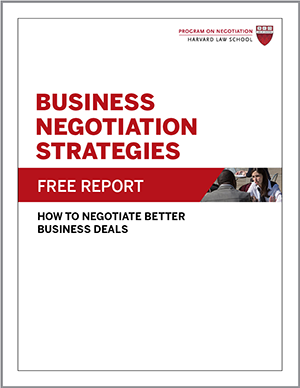
Business negotiators across industries can absorb key lessons from mergers and acquisitions (M&A) negotiation strategy—including choosing the right negotiating partners, considering the role of outside parties, and preparing for effective deal implementation.
1. Who might influence a reluctant counterpart?
It’s a common problem in business negotiation: You have a vision for a deal that you expect to benefit both parties, yet the other side won’t even come to the table. In their book 3-D Negotiation: Powerful Tools to Change the Game in Your Most Important Deals, David Lax and James Sebenius suggest that an indirect route to your target may be the best strategy. Through a process they call backward mapping, you can think in reverse about how to reach your preferred outcome and then ensure you are approaching negotiating partners in the right order.
Backward mapping can be a pivotal aspect of M&A negotiation strategy. Consider what happened when US Airways CEO Doug Parker called American Airlines head Tom Horton to discuss a possible merger on November 29, 2011, the very day American filed for bankruptcy, as reported by Mike Spector in the Wall Street Journal. Horton said his airline needed to spend time reorganizing and renegotiating its labor contracts before focusing on a deal.
4 Steps for Backward Mapping
By negotiating first with American Airlines’ pilots union, US Airways CEO Doug Parker secured an agreement that caught the attention of American’s leadership. Draw on the principle of backward mapping in your own deals by following these four steps from David A. Lax and James K. Sebenius:
-
- Make a map of all the counterparts who could potentially be involved in your negotiation and consider their interests.
- Estimate the costs and benefits of getting each party on board with your plan.
- Identify the patterns of influence and deference among these parties. Who listens to whom? Who owes something to whom?
- Consider what agreements need to be in place to secure your ultimate target’s cooperation. Whom do you need to negotiate with first, and how can you win that person over?
Undeterred, Parker touted the benefits of a merger with American on Wall Street, and US Airways president Scott Kirby launched an informal contract negotiation with American’s pilots union. On April 20, 2012, US Airways announced that all of American’s large unions supported a merger between the two airlines. The same day, US Airways issued a formal merger proposal to American and its creditors.
This time, American agreed to explore a possible consolidation. Confidential negotiations led to a new proposal from US Airways: American’s shareholders, creditors, unions, and employees would get 70% ownership of a combined airline, US Airways’ shareholders would get 30%, and Parker would run the company.
In February 2013, the companies unveiled their merger, which was widely praised as a critical step in industry consolidation. Pivotal to the deal was CEO Parker’s recognition of the importance of negotiating with American’s pilots first. Their enthusiasm for a merger made it difficult for Horton to resist negotiations with American.
2. How will the deal affect your rivals?
Office Depot’s intended purchase of OfficeMax, announced on February 20, 2013, was widely praised as an important step toward consolidating the office-supply industry, which was suffering from a glut of stores amid competition from Internet retailers such as Amazon.
The day after the merger announcement, shares of rival Staples rose 13%, a market-capitalization gain of $1.1 billion—about three times the amount of the combined $314 million gain for Office Depot and OfficeMax. This relief for Staples didn’t last over time, but it points to the importance in M&A negotiation strategy of considering how the outcome of a negotiation will affect outside parties, including rivals. Assess in advance whether there will be enough value to go around—or if you could end up losing out to a newly bolstered competitor.
3. What will happen next?
If negotiating a merger between two complex corporations seems difficult, integrating the companies after the deal closes is typically even harder. When Office Depot and OfficeMax announced their partnership—prematurely, because of a third-party error—they had yet to resolve key questions, such as the name of the combined company, who would lead it, and where it would be headquartered.
More often, companies flesh out organizational plans during the negotiation process. US Airways and American, for instance, agreed that US Airways’ Parker would lead the newly christened American Airlines Group from American headquarters, and the company had a head start on labor negotiations.
But the consolidation challenges were daunting. The carriers needed to take American out of bankruptcy, pass a Justice Department antitrust review, and integrate their massive operations and differing cultures, all while facing competition from rivals United and Delta Airlines.
In Horton’s words, the deal represented “great value creation, but it’s all dependent on execution.” Acknowledging such realities is critical to M&A negotiation strategy and any new partnership, so be sure to take a long-term view of possible challenges before closing a deal.
3 Takeaways from M&A Negotiation Strategy
- Map backwards. When faced with a reluctant counterpart, think about what other parties you might approach first. The agreements you reach with these parties may help you make inroads with your ultimate target.
- Anticipate rivals’ reactions. In the midst of your negotiations, take time to analyze how third parties in your sphere may be affected—both positively and negatively—by your deal.
- Look beyond the contract. Because the deal isn’t done when the ink dries, devote a significant percentage of your negotiation time to planning how you will implement your agreement.
What lessons have you learned from M&A negotiation strategy in the news?





